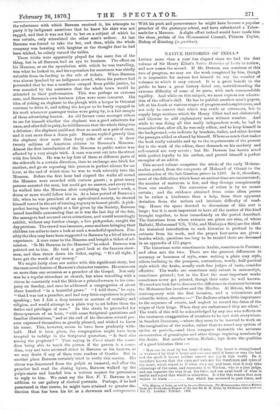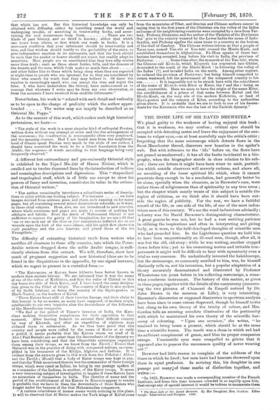TIVE HISTORIES OF INDIA.*
thing, but in all Barnum had an eye to business. The effect on LITTLE more than a year has elapsed since we had the first volume of Sir Henry Elliot's _Vallee Histories of India to review, his Museum, or on the speculation with which he was travelling,
was what he looked to, and his reputation for smartness was chiefly and now comes the second. if Mr. Dowsou calfcontinue at this rate of progress, we may see the work completed by him, though was almost lynched by an indignant crowd, whom his partner had it is impossible for anyone but himself to say the number of persuaded that he was a murderer escaped from public justice, be volumes to which it may extend. It is a great benefit to the was consoled by the assurance that the whole town would be
public to have a great history doled out, notwithstanding the 13
extreme difficulty of some of its parts, with such commendable rapidity. Aud while on this subject, we must express our admire- tion of the editor's skill. He has to publish another man's papers, costume to drive it, and telling the keeper to be busily engaged in left at his death at various stages of progress and completeness, and his work whenever passenger trains were going by, is a fair sample not only to correct that which was crude or erroneous, but to supply large sections which Sir Henry Elliot had not elaborated ; to see for himself whether the elephant was a good substitute for and likewise to add explanatory notes without number. And oxen, and after full inquiry, he told Barnum that the whole thing was while be was doing all this really independent work, he had to a delusion ; the elephant could not draw as much as a pair of oxen, remember that, after all, he was only editor, and to keep himself in and it cost more than a dozen pair. Barnum replied gravely that the background, —to indicate by brackets, italics, and other devices the passages added or altered by himself. Where so much that makes the book really valuable and up to the requirements of the present Almost the first introduction of the Museum to public notice was day is the work of the editor, these demands on his modesty and effected by a very simple trick. A man was sent out into the street self-control are very severe ; but Mr. Dowson has herein acted with five bricks. He was to lay four of them at different parts of with perfect loyalty to his author, and proved himself a perfect the sidewalk in a certain direction, then to exchange oue brick for exemplar of an editor.
from the Posthumous Papers of the late Sir H. M. Elliot, by Professor John Howson.
that which has not. But this historical knowledge can only be obtained with difficulty, either by travelling round the world and undergoing trouble, or searching in trustworthy books, and ascer- taining the real occurrences from them There are two kinds of past history, and no third is known ; either that which one hears from others, or that which one reads in books. It is a necessary condition that your informant should be trustworthy and true, and that wisdom should testify to the probability of the story, to give independent sanction to its statements, and that the book should be such that the render or hearer should not reject, but readily adopt its assertions. Most people are so constituted that they love silly stories more than truth ; such as those about fairies, hills, and the demons of the deserts and the seas, which fools make so much fuss about and other fables like to these which bring sleep when they are repeated at night-time to people who nre ignorant, for so they are considered by those who search for truth that they may believe it. Of these the number is exceedingly small, who can accept the true and reject the false. I, who have undertaken the history, have endeavoured so to manage that whatever I write may be from my own observation, or from the accounts I have received from credible informants."
Nevertheless, his work is " related with such detail and verbosity as to be open to the charge of prolixity which the author appre- hended The writer may not inaptly be described as an Oriental Mr. Pepys."
As to the manner of this work, which makes such high historical pretensions, we learn :—
" The style of the work is a most singular kind of colloquial Persian, written down without any attempt at order and the due arrangement of the sentences ; the construction is consequently often very perplexed, and the meaning obscure. Had I not heard men from the neighbour- hood of Ghazni speak Persian very much in the style of our author, I should have conceived the work to he a literal translation from the Arabic, the sequence of words according to that language being very frequently observed."
A different but extraordinary and pre-eminently Oriental style is exhibited in the Taju-1 Ma-Cisir of Hasan Nizami, which is swelled out to twelve thousand lines by the introduction of tedious and meaningless descriptions and digressions. This "rhapsodical and tropological stuff, which is of little use except to show his powers of fancy and invention, constitutes its value in the estima- tion of Oriental writers."
"The author occasionally introduces a subordinate series of descrip-
tions or sifats within one loading subject. For instance we have images derived from mirrors, pens, and chess, each running on for many pages, but all containing several minor descriptions referable, as it were, to those chief subjects. Here, also, we are introduced to new conceits, where whole sentences and pages are made to consist of nothing but sibilants and labials. Even the death of Muhammad Ghazni is not sufficient to repress the gaiety of his imagination, for we are told that one or two men out of the three or.fonr conspirators inflicted fire or six wounds upon the lord of the seven climes, and his spirit flew above the eight paradises and the nine heavens, and joined those of the ten Evangelists.' "
The difficulty of extracting historical truth from writers who sacrifice all clearness to these silly conceits, into which the Perso- Arabic writers dragged down the noble Arabic tongue, is suffi- ciently obvious from this extract. We will, therefore, show how much of pregnant suggestion and new historical ideas are to be found in the disquisitions in the appendix, by one signal instance, which we regret to present in a curtailed form :—
" The IC/dorm:ins, or Kators, have hitherto been better known to modern than ancient history. We are informed that it was the name of one of the tribes of Racist:in. and that the ruler of Chitral to this day bears the title of Shah Kator, and I have beard the same designa- tion given to the Chief of Gilgit. The country of Kator is also spoken of by Stidik Isfahani. as being the country of the Siyah-poshes, or Black-Vested, on the borders of Kabul.
"These Kators boast still of their Grecian lineage, and their claim to this honour is by no means, as many have supposed, of modern origin, attributable to our own inquiries after the descendants of the followers of the Macedonian conqueror.
"We find at the period of Timur's invasion of India. the Kato- rians making themselves conspicuous for their opposition to that monarch. After leaving Inderab he entered their difficult country by way of Khawah, and after an expedition of eighteen days reduced them to submission. As we thus have proof that this country and people were called by the name of Kator at so early a period, it seems probable that the Kators whom we read of in Abti-1 Fazl Baihaki are no other than the descendants of the dynasty we have been considering, and that the Ghaznivide sovereigns organized them among their troops, as we know from the Tdrith-i Yamini that Mahmtid was in the practice of doing with conquered nations, as exem- plified in his treatment of the Khiljis, Afghans, and Indians. It is evident from the extracts given in this work from the Tabakdt-i Akbari and the Terikh-i Mastidi that a body of Kator troops was kept in pay, and that the Tilak mentioned therein was the commander of these foreign troops, which were rated as Indian. he being in one passage spoken of as commander of the Indians, in another, of the Kator troops. It opens a very interesting subject of investigation to inquire if these Kators have no memorials of themselves in India. The identity of name and the period of the establishment of the Kators in Kumatin appear to render it probable that we have in them the descendants of those Kators who fought under the banners of the first Muhammadan conquerors.
0 A curious coincidence of names seems worth noticing in this place. It will be observed that Al Birtini makes the Turk kings of Kabul come from the mountains of Tibet, and Grecian and Chinese authors concur in saying that in the first years of the Christian era the valley of the Indus and some of the neighbouring countries were occupied by a race from Tar- tary. Ptolemy,Dionysius, and the author of the Periplus of the Erythrean Sea' give to the country watered by the Lower Indus the name of Indo- Scythia. and Ptolemy applies the same name to a country at the bottom of the Gulf of Cambay. The Chinese writers inform us that a people of Tatar race, named Yne-chi or Yue-tchi crossed the Hindti-Kush, and established themselves in Afghanistan. Fa-Hian speaks of these bar- barians having occupied, long before his visit to India, the province of Peshawar.. Some time after, the monarch of the Yne-tchi, whom the Chinese call Ki-to-lo, which Klaproth has converted into Ghidor, descended to the south of the Hindu-Kush in following the valley of the Indus ' (?), and invaded India on the north. Among other regions, ho reduced the province of Peshawar; but being himself compelled to return westward, left the government of the conquered country to his
son . It is impossible not to be struck here with the coincidence of the name of Ki-to-lo with Kitor or Kator, the 1 and the r being, as usual, convertible. Here we seem to have the origin of the name Alter, the establishment of a prince of that name between Kabul and the ilinffil-Kush, on the very site of the modern Kafiristan, or land of Siyab-posher and the country of Kitor, according to the authorities given above. It is probable that we are to look to one of his descen- dants for the Katorman who was the last of the Turkish dynasty."



































 Previous page
Previous page